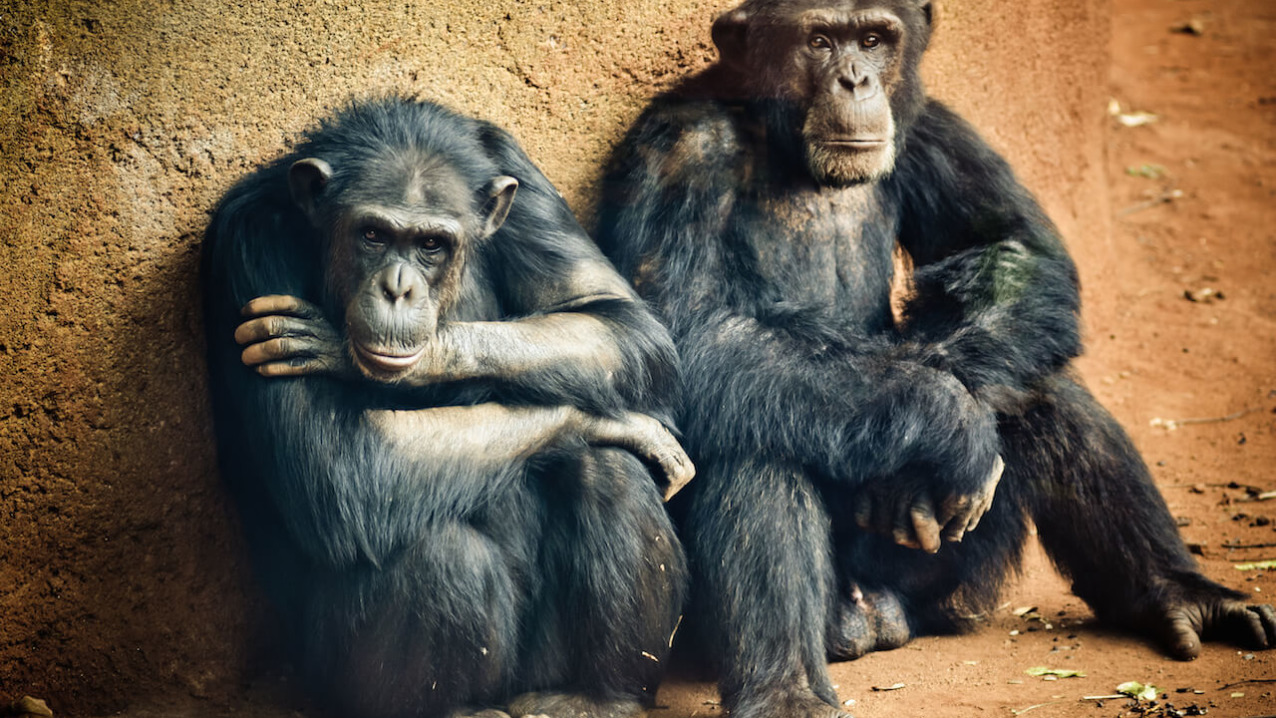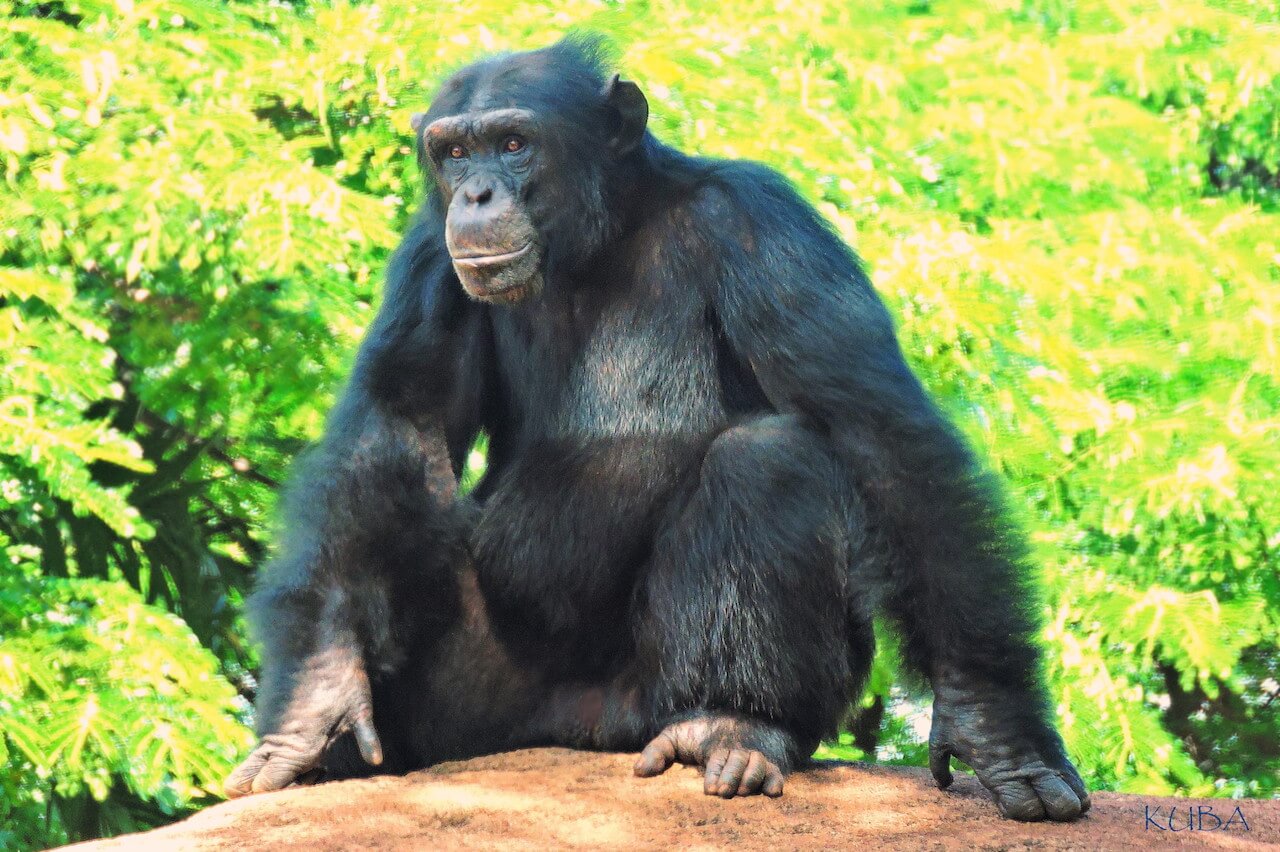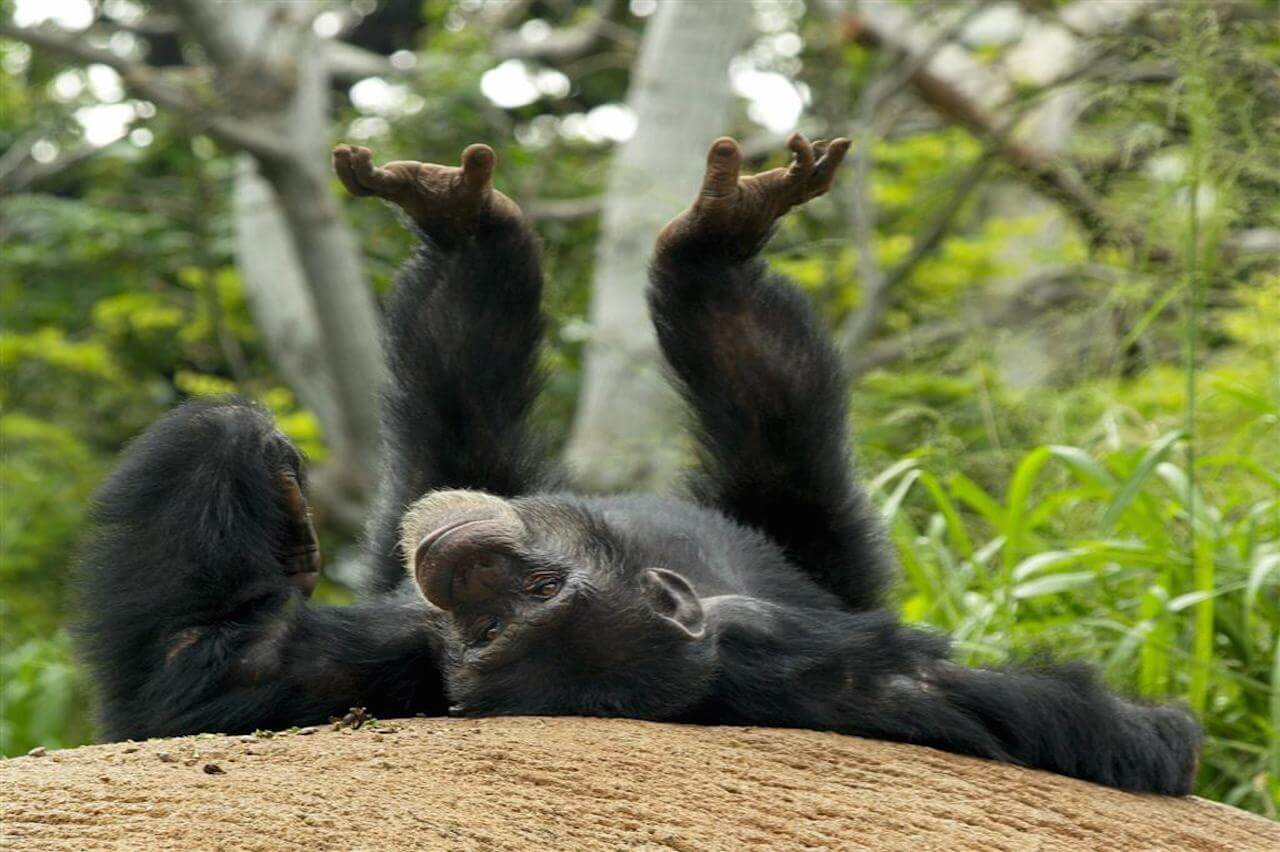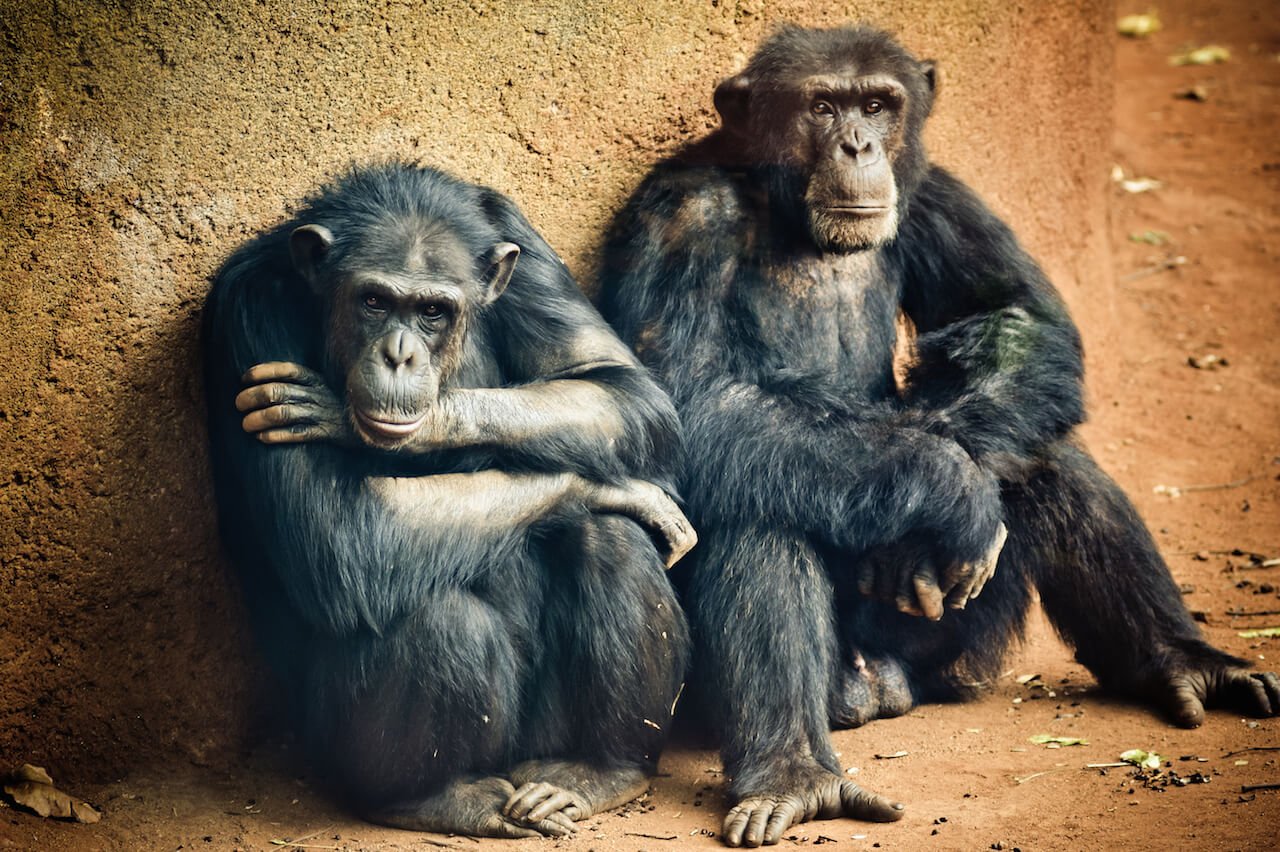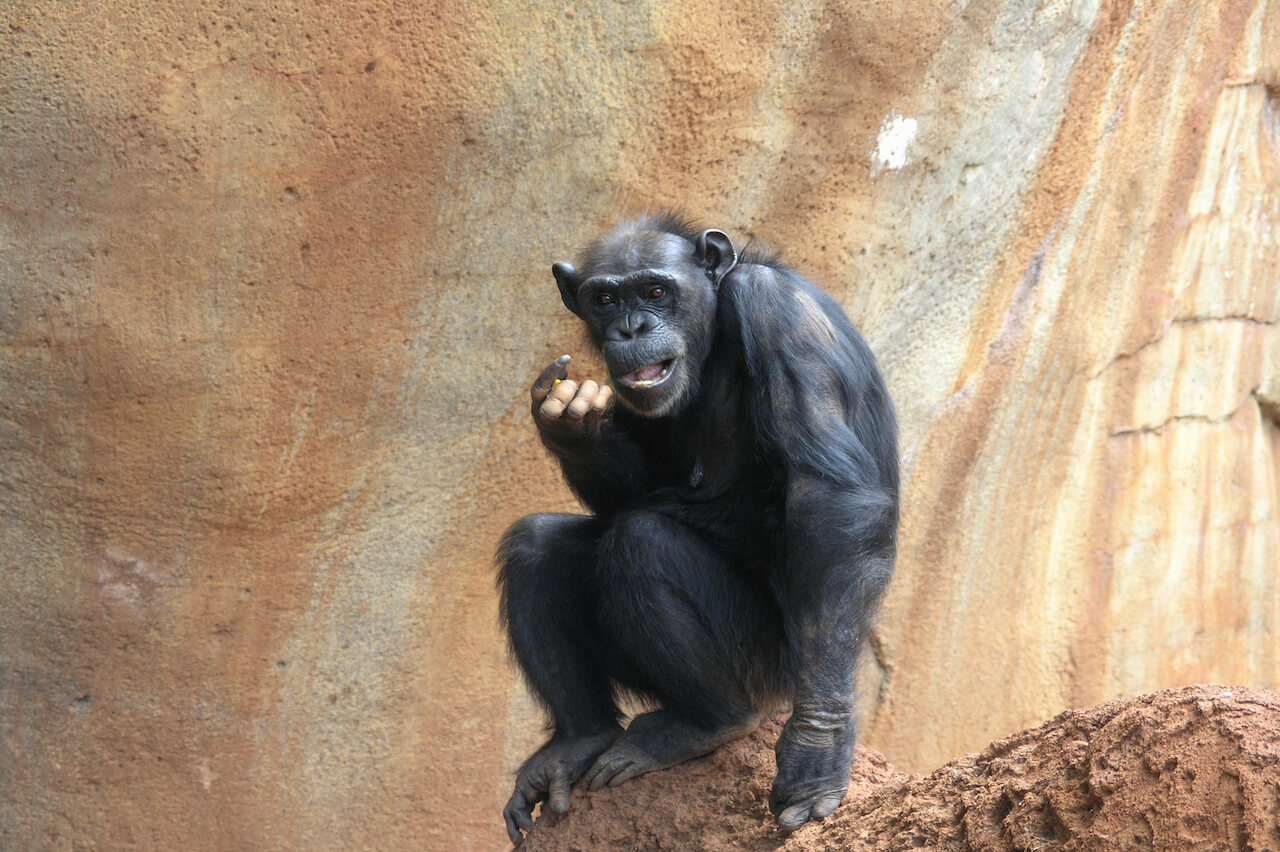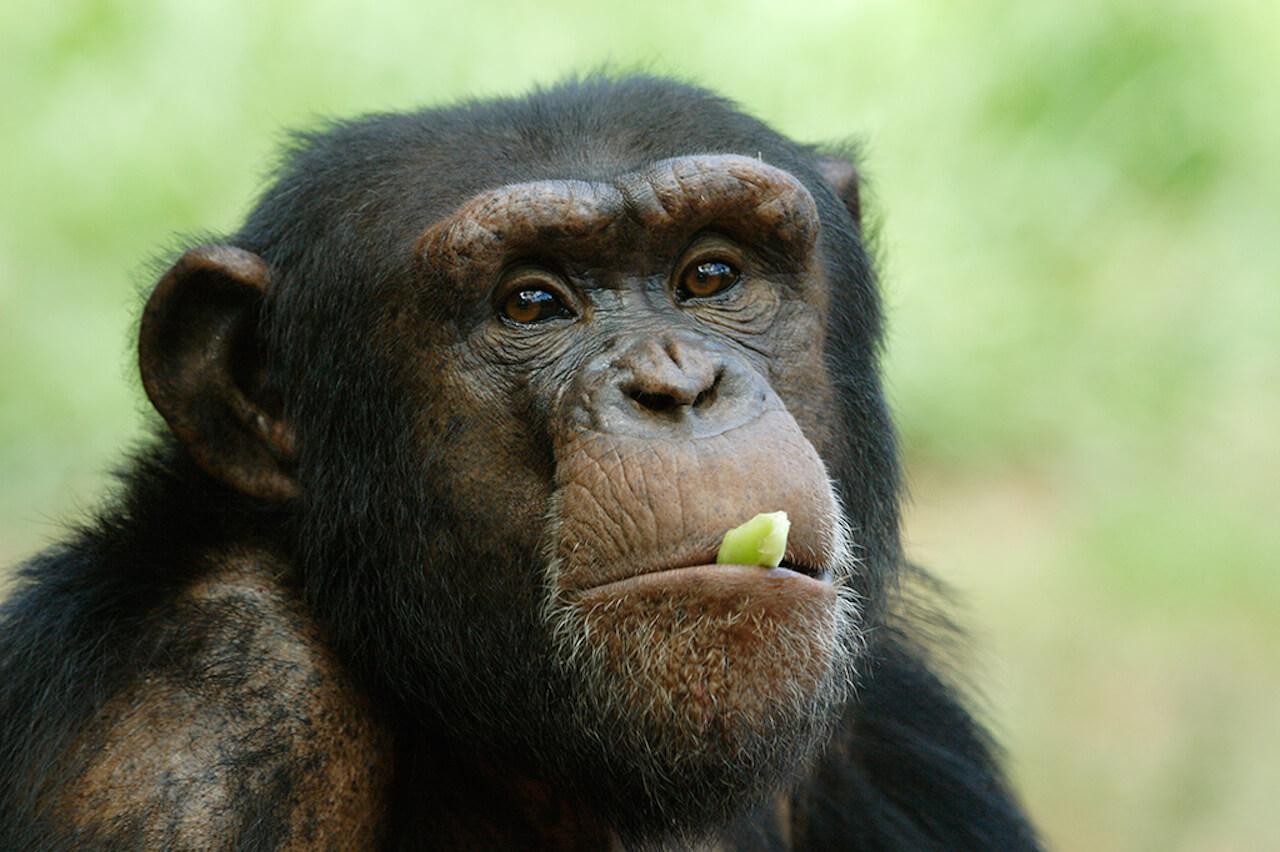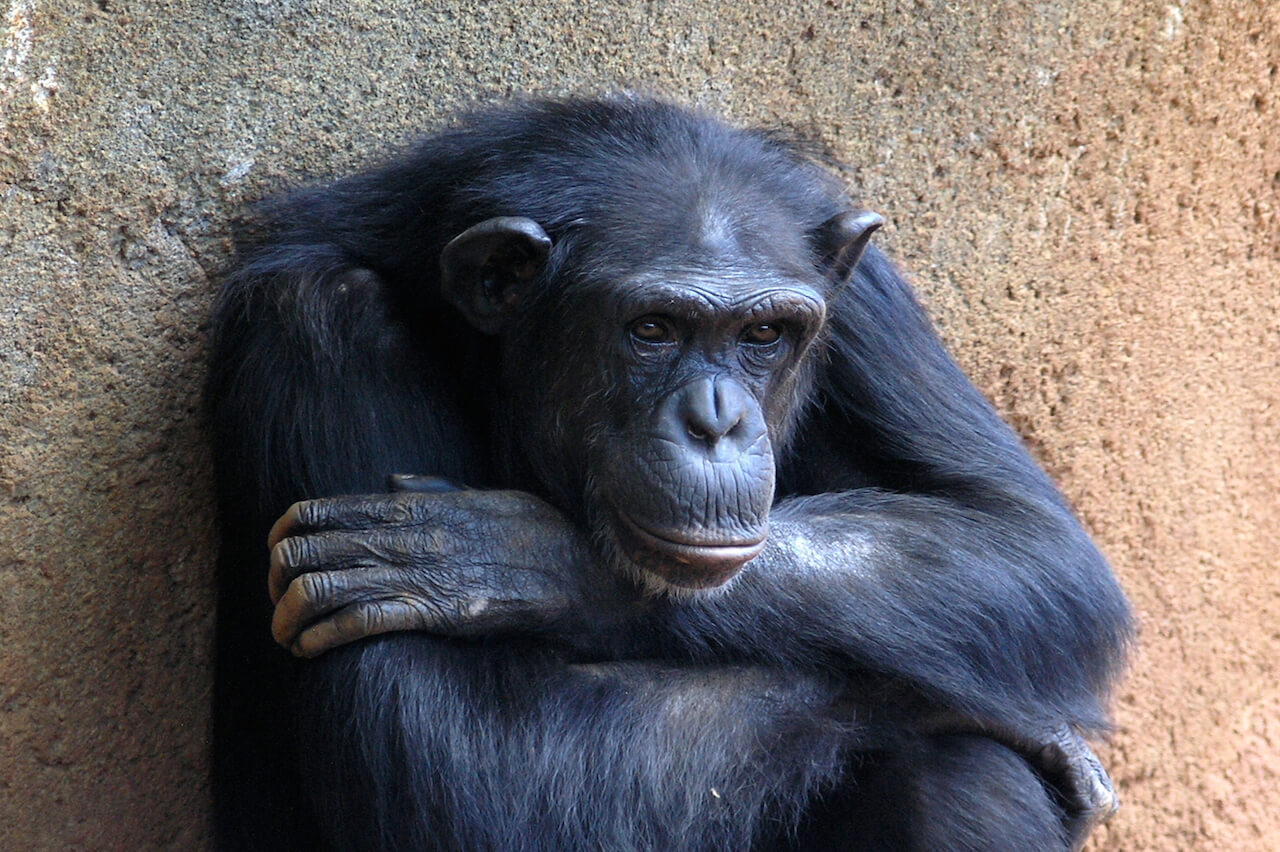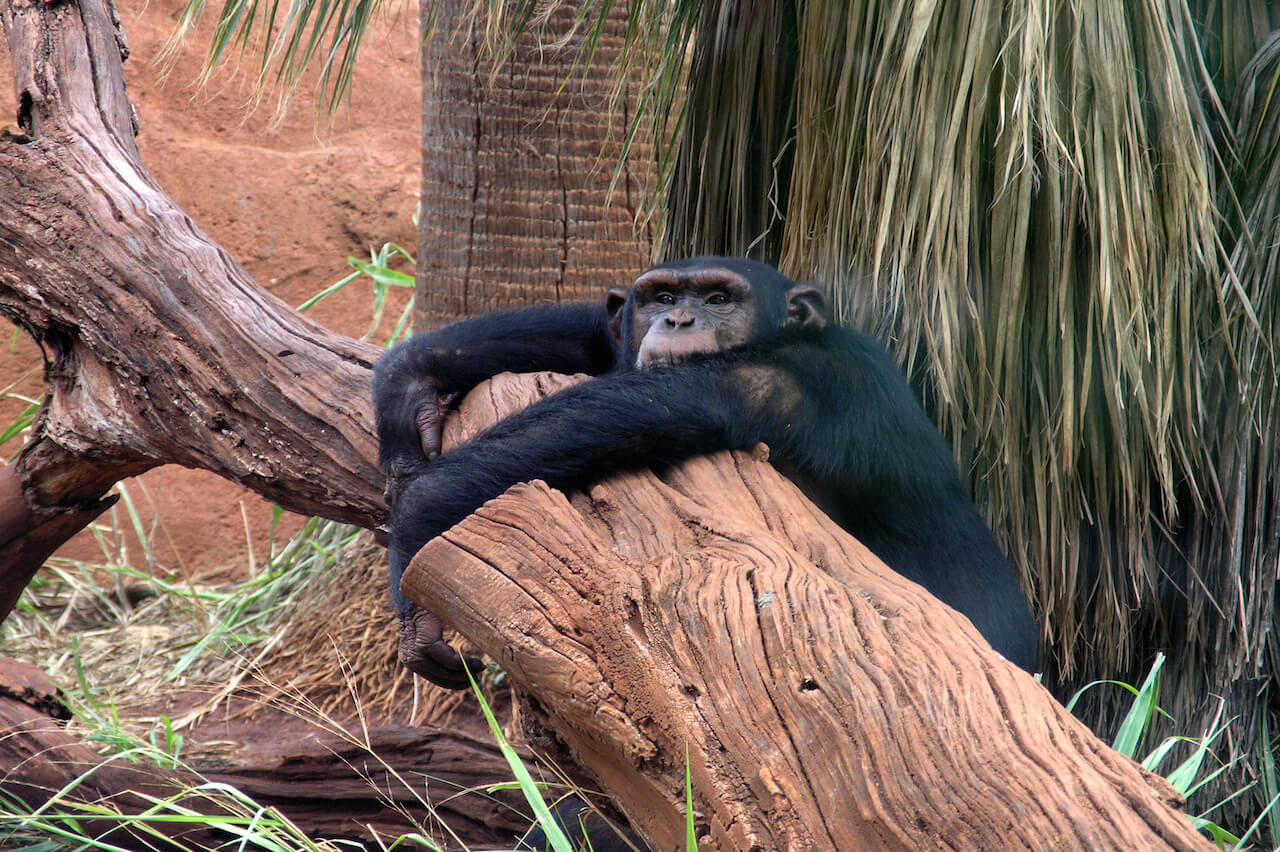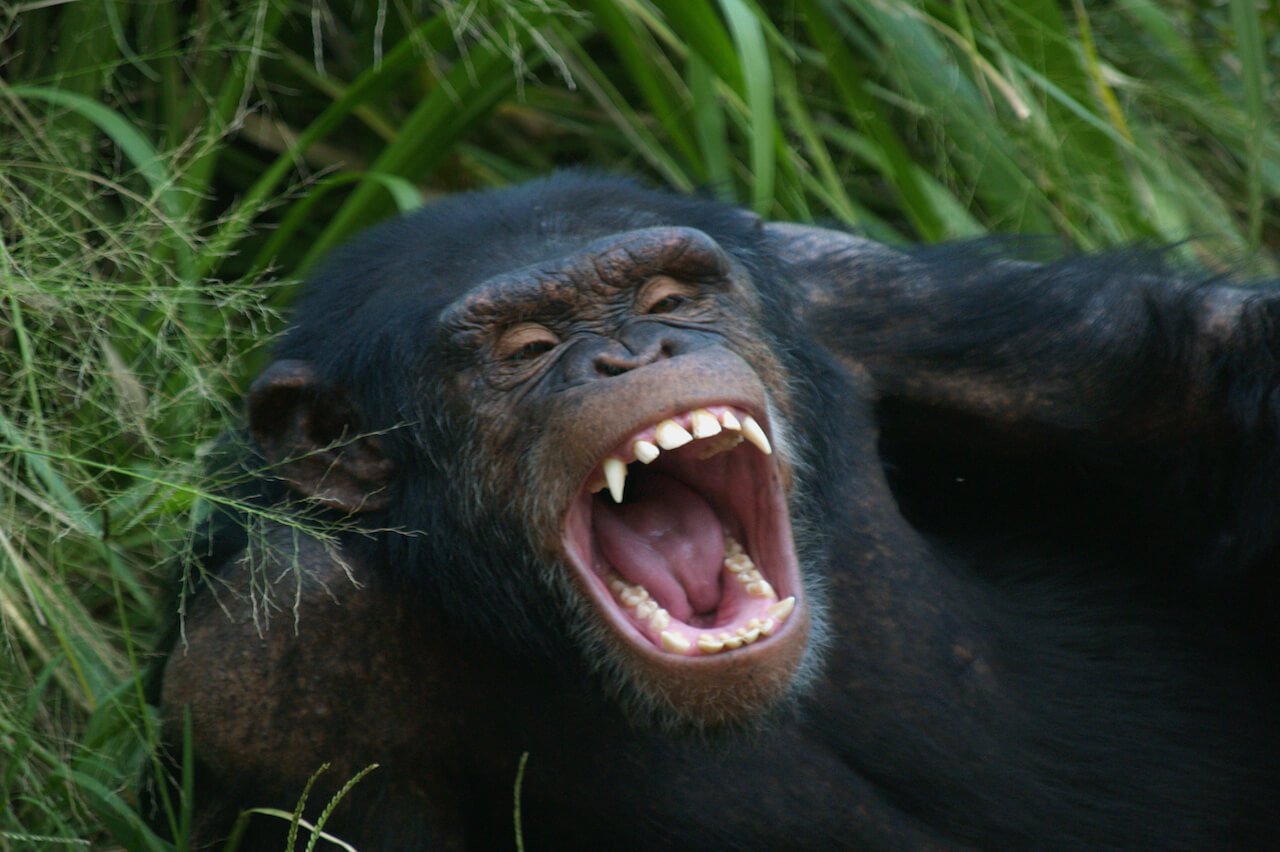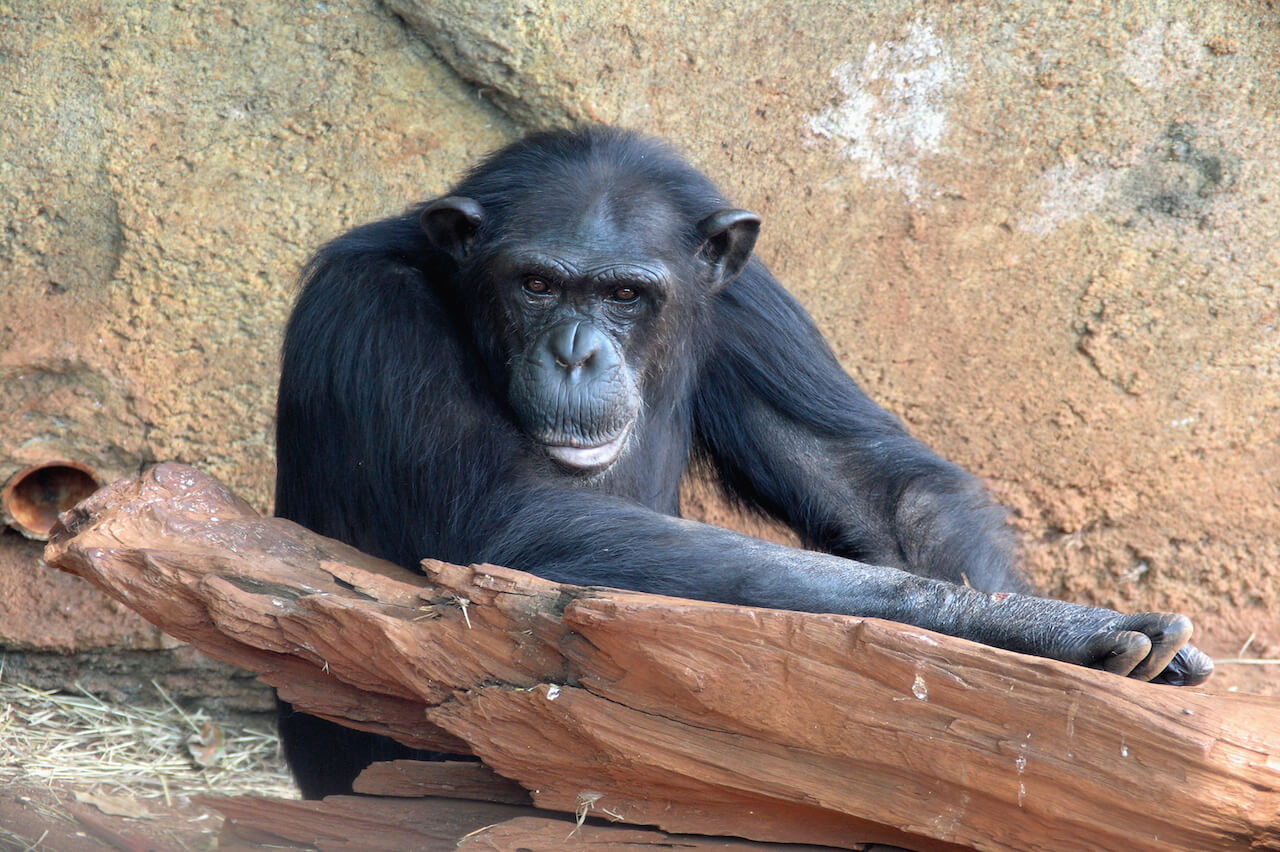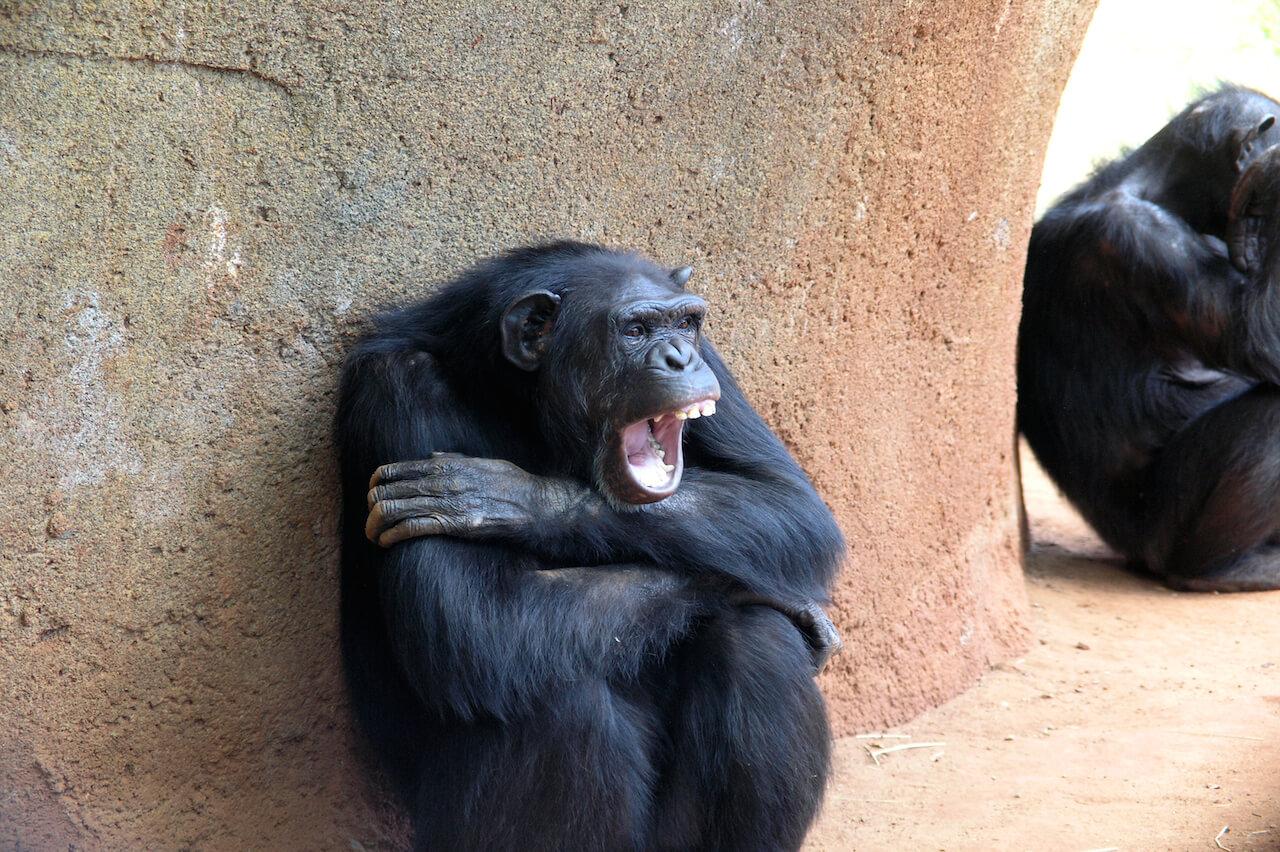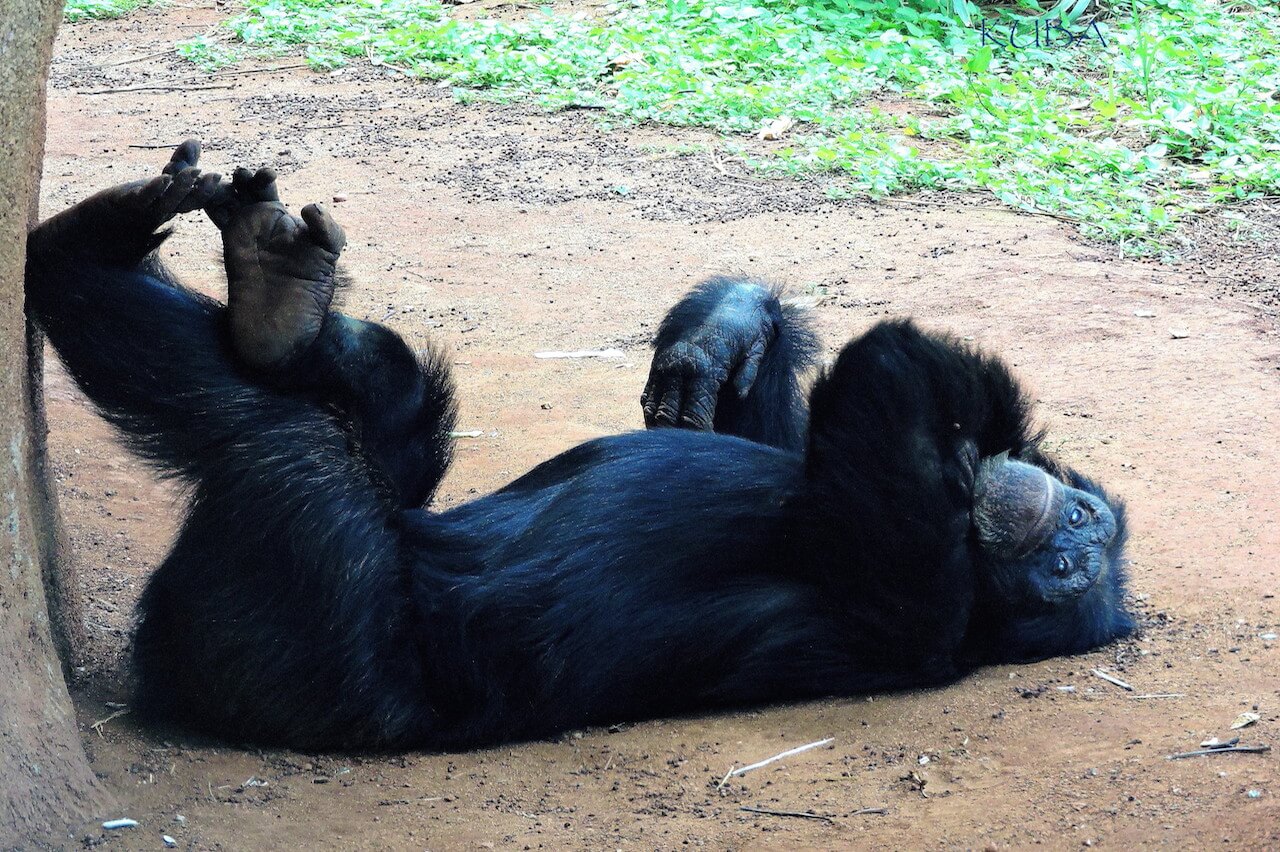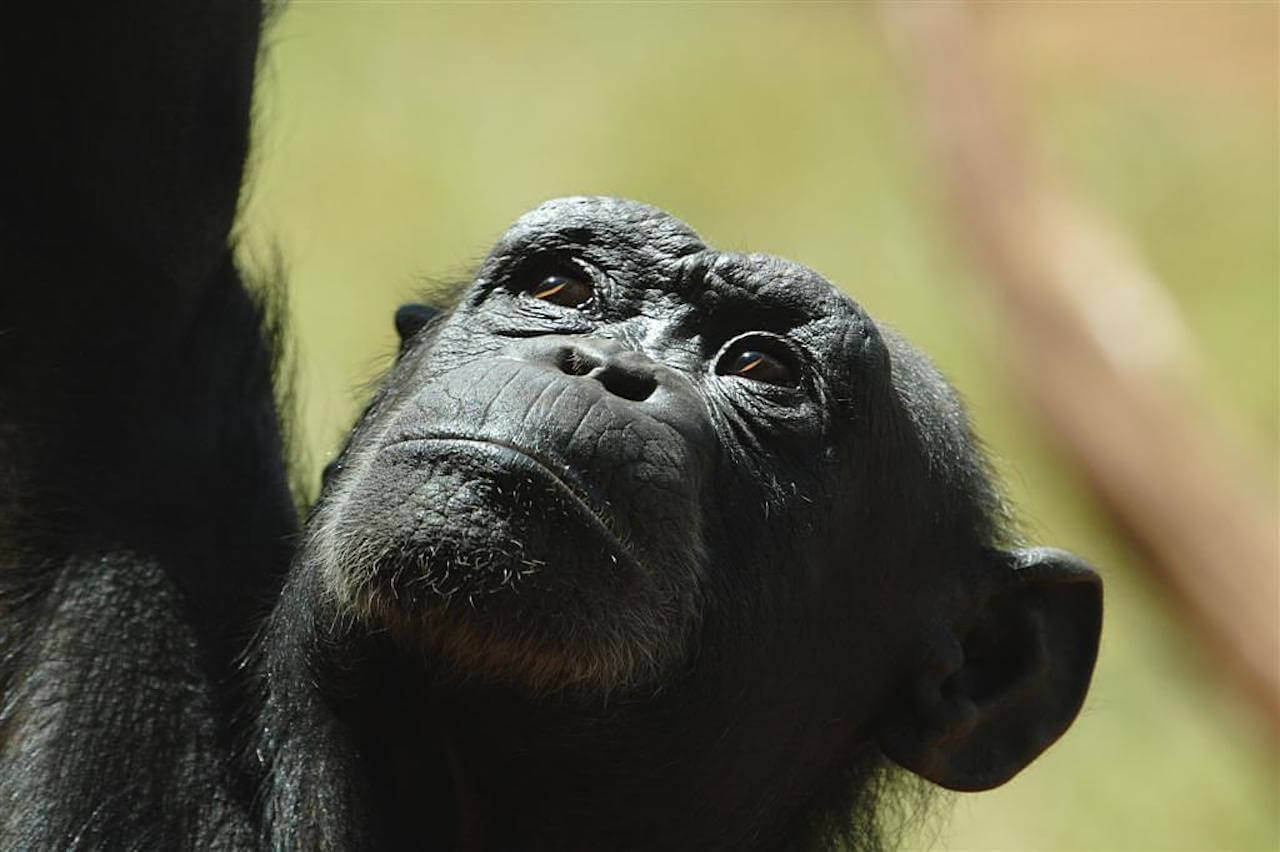pan troglodytes
Chimpanzee
About Me
Scientific Name: Pan troglodytes
Description
The Common chimpanzee occupies a broad range compared to the bonobo and can be found in 21 African countries. They are found north of the River Congo in humid closed-canopy forests, montane forest (up to 6,500 ft.), seasonally dry forests and savanna-woodlands. Population densities vary from area to area. When occasionally seen on flat savannas it is only while moving from one forest patch to another.
Fun Facts
- The play face is when the mouth is slightly open and in a relaxed position, meaning all is calm.
- Chimpanzees and bonobos are equally humanity’s closest living relatives. As such, they are among the largest-brained, and most intelligent of primates.
- Kingdom: Animalia
- Phylum: Chordata
- Class: Mammalia
- Order: Primates
Common chimpanzees (Pan troglodytes) and bonobos (Pan paniscus) are considered our closest living relatives by a majority of the scientific community. From analyzing extensive genetic evidence, we shared a common ancestor about 6 million years ago. From that point forward however, a divergence took place and led to modern gorillas. Bonobos then diverged from ancestral chimpanzees about 1.5 million years ago, when a group of them moved south of the Congo River and became an isolated population. This isolation and change to a lowland tropical forest habitat, resulted in their evolving into a separate species.
There are four subspecies of the Common chimpanzee. The Western or Masked chimpanzee (P.t. verus), the Black-faced chimpanzee (P.t. troglodytes), Long-haired chimpanzee (P.t. schweinfurthi) and one which has not been given a common name (P.t. vellerosus).
Of the several subspecies of chimpanzees in the wilds of Africa. the Common, and bonobo, are more prevalent. The bonobo, has in the past, been referred to as the “pygmy chimpanzee and this is a misnomer. Even though they have a more slender body and different shaped head than the common chimpanzee, they weigh as much as the smallest of the subspecies. Both have stout bodies with backs sloping evenly down from shoulders to hips. They have highly mobile shoulder joints and long arms, opposable thumbs and opposable big toes that make it easy for precision gripping. Their arms extend below the knees when the animal is standing and has a spread that is about 50% greater than the animal’s height. Both species have large brains (300-400cc) and are equally relative to their body size.
The face is usually bare and generally black in color. Younger animals have flesh-colored ears, nose, hands, and feet, and a white patch near the rump. At maturity, the overall skin color is dark, and the fur varies from deep black to light brown. After about the age of 20, they will develop gray hair on their backs. The hair on the head may grow in many directions, and both sexes are prone to partial baldness early in maturity. Both sexes will often have a short white beard.
Males of both species are 20 to 30% larger than females, and have bigger canine teeth which they use in severe fights. Body proportions are otherwise similar and both sexes have prominent genitals. Chimpanzees and bonobos can stand upright and are well adapted for arboreal activities where they do most of their feeding and sleeping.
The Common chimpanzee occupies a broad range compared to the bonobo and can be found in 21 African countries. They are found north of the River Congo in humid closed-canopy forests, montane forest (up to 6,500 ft.), seasonally dry forests and savanna-woodlands. Population densities vary from area to area. When occasionally seen on flat savannas it is only while moving from one forest patch to another. Because they have quite varied tastes, it allows the common chimpanzee to live in a wider variety of habitats compared to gorillas, bonobos and orangutans.
Common chimpanzees are very social animals and have a male-bonded society. All adult males are dominant over all females. Females do not develop strong social bonds with each other like the males do. Community size can range from 15 to 150 members; all seeming to share some social bond. Communities tend to get along reasonably well with each other; however the Common chimpanzee tends to show more antagonism toward outsiders than do bonobos. Extreme aggression leading to death by male coalitions in the mammal world is unusual; among primates it occurs only in chimpanzees and humans. The only members of a group that are able to move freely between communities are adolescent females who haven’t yet given birth. Males stay with their natal family for life.
Males of a community regularly patrol their boundaries in search of intruders and depending on a number of circumstances, encounters can sometimes lead to brutal attacks. When foraging or hunting for food, large communities are broken up into smaller parties (of about 3 to 10 members). These parties will vary in size and composition, according to the time of year and availability of food. For example a large party will be formed when there is an abundance of fruit in their range. During foraging, a chimpanzee group might cover up to 9 miles (15km) in a single day when food is scarce.
Male chimpanzees tend to share food or possessions mostly with other males who are allies or grooming partners. There will be dominant possessors in any group and they decide who gets what and how much, if any. These possessions may have been garnered personally or stolen from a subordinate chimp. Reciprocity has often been observed between males when meat is involved and females seem to have more success in getting meat from a males when in estrous.
Physical contact is an important part of maintaining good relationships in the group; with grooming being the most important social activity. Being a male bonded society, you will see males grooming each other, more often than males and females grooming one another. Grooming serves to improve and strengthen friendships and calm members that are upset. Females tend not to groom as much as males.
Chimpanzees travel mostly on the ground, where they “knuckle-walk,” like gorillas. They have physiologically adapted to this by developing a ridge of bone that keeps the wrist from buckling under the weight of the body. They sleep in “nests,” that are leafy beds made fresh each night. Adults sleep alone and infants with their mothers until the next sibling is born.
Chimpanzees use tools to solve a greater range of problems than any other animal, apart from humans. Sticks or plant stems are used to get ants and other insects by inserting them into holes. They also use sticks or rocks to break open fruits and seeds with shells too hard to bite open.
Communication: Posturing, facial expressions and gestures are used to convey specific messages between individuals. Social bonding is extremely important to chimpanzees and they will use a number of facial expressions to communicate what they are feeling. You may recognize some of the following facial expressions when visiting chimps at a zoo.
The play face is when the mouth is slightly open and in a relaxed position, meaning all is calm.
The pout is when the lips are puckered as if offering a kiss and is commonly used when begging for food. A horizontal pout indicates a show of submission, often after an attack and may be accompanied by a whimpering sound.
The display face is a hostile expression showing teeth in an wide open mouth with facial hairs erect and is used during attacks or when it needs to display aggression. When lips are pulled back horizontally, it indicates fear and when they are pulled back vertically, it indicates hostility. These expressions may also be accompanied by screams.
A full open grin is an indication of intense fear or some other form of excitement. A fear grin might be seen when a lower ranked chimp is approached by a higher ranking animal. Lip smacking greetings are used by chimps as a sign of friendly submission.
Chimpanzees have similar sensory abilities to people. Their large brains reflect a consistently high performance on all intelligence tests devised by humans and have shown an ability to engage in symbolic communication while in captivity. In the wild they communicate using a variety of visual and vocal signals, but this type of communication doesn’t appear to use symbols. Individual chimpanzees have his or her own distinctive pant-hoot call, which enables the caller to be preciously identified. No two chimps have the same call. Both species are very adept at manipulating the behavior of others, whether it be another chimp or a human. Zookeepers who work with chimpanzees know this all too well!
Chimpanzee diets are composed mainly of ripe fruits but vary according to the time of the year and abundance of specific food items. They will spend many hours a day eating about 20 different species of plants and up to about 300 different species during a one year period. They do not store food and will eat it at the place they find it. They also enjoy eating young leaves particularly in the afternoon. In long dry seasons when fruit is scarce, tree seeds, flowers, soft pith, galls, resin and bark become an important part of their diet.
They also eat many different types of insects, however termites are the most nutritionally important. Termites are collected either by hand or with tools which are modified by the chimp and specifically used for this purpose. Many zoos, including the Honolulu Zoo, have built termite mounds to simulate this natural behavior of feeding. See our termite mound enrichment. Females spend twice as much time eating insects as males do. Birds are occasionally eaten. Mammals such as monkeys, pigs and antelope are also eaten, particularly by males, but along with termites only account for about 5% of their diet.
Hunting style varies from one population to another depending upon the type of habitat. The amount of cooperation between males in a group will affect the hunting success. An abundance of fruit in a particular area where there are a large number of monkeys, will result in a higher hunting success rate; mostly because the chimps will have the highly needed energy from the fruit to pursue the monkeys. Most carnivores have a less than 50% success rate when hunting; however, the success rate for chimpanzees hunting red colobus monkeys is between 50 and 80%.
Longevity in the wild is 40 to 45 years with exceptional animals reaching 50. There are chimps in captivity that have lived more than 60 years. Weight varies greatly between wild populations and zoos. The animals in Zoo populations tend to be larger, with males weighing in at almost 200 lb(90kg) and females at about 175lb(80kg). Males in the wild may be as small as 88lb(40kg) and females 66lb(30kg). Males reach full adult size at about the age of 16, but females will reach adult size earlier.
Mating success is positively correlated with the male dominance rank. Females in captivity mature earlier than wild females and might begin mating at 8 or 9 years old, but will go through adolescent sterility for about two more years before being able to conceive. Wild females mature 3-4 years later. There is an average of 5 to 6 year intervals between surviving births. A single young is born after a gestation of 230-240 days and twins are rare.
The newborn chimpanzee is helpless, with only a weak grasping reflex and needing support from the mother’s hand during travel. Within a few days it clings to the mother’s underside without assistance and begins riding on her back at 5-7 months. By 4 years of age the infant travels mostly by walking, but stays with its mother until at least 5-7 years old.
Endangered
The main threat to chimpanzees comes from habitat destruction, particularly commercial logging in Ivory Coast and central Zaire. Given their low reproductive rate, chimpanzees are highly vulnerable to loss of habitat or populations.
Jane Goodall says: “At the turn of the last century there were some 2 million wild chimpanzees in Africa. When I began my chimpanzee research in 1960, there must have been well over a million. Today at most an estimated 150,000 chimpanzees remain. And for other primates, the situation is even more alarming.” To sustain the removal of wildlife for the dinner table, animals must be able to reproduce fast enough to replenish their number and this is not happening. In some areas of Africa the removal of wildlife for the bushmeat trade is a greater threat than deforestation.
Bonobos are far less common than the common chimpanzees and they face similar population pressures. Unlike chimpanzees, bonobos do not have a viable captive breeding population. Many chimps and bonobos fall victim to snares that are set for other animals, habitat destruction, bush meat trade and military conflict.
The Honolulu Zoo’s chimpanzees arrived January 27, 1994 from St. Louis Zoo, Missouri, where they were exhibited from an indoor exhibit with an artificial environment. The Honolulu Zoo’s exhibit provides our chimpanzees with their first real experience in a natural setting. This replicates their natural habitat with trees, grasses, rocks, dirt and a temperate climate in the in which they are thriving as a social group.
Roscoe is the oldest adult breeding male and was wild-caught. He was replaced in the hierarchy as alpha male in 2002 by Kibale after being separated from the group while recovering from a broken leg.
Name Sex DOB
Roscoe M 04-16-72
Kumi F 08-24-79
Nalu M 06-15-95
Ke’aloha M 11-30-94
Name Sex DOB
Kibale M 05-06-90
Boo F 09-06-70
Tatu F 01-24-86
Konakona M 11-27-93
Puiwa M 08-20-99
Other Mammals
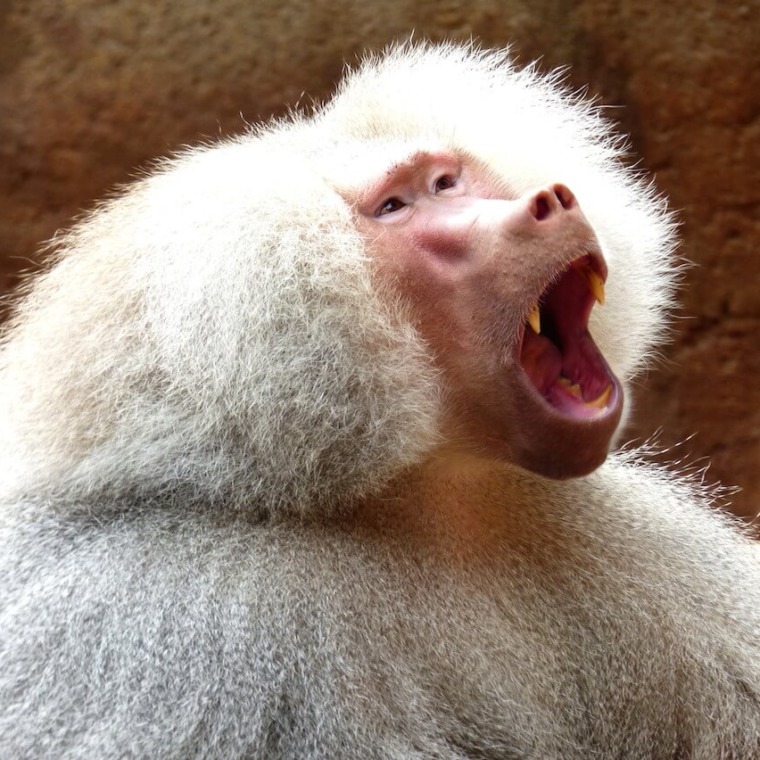
Sacred Baboons are common throughout northeastern Africa, but are extinct in the Nile region and Egypt, where they originally received their name and were worshiped by the ancient Egyptians.
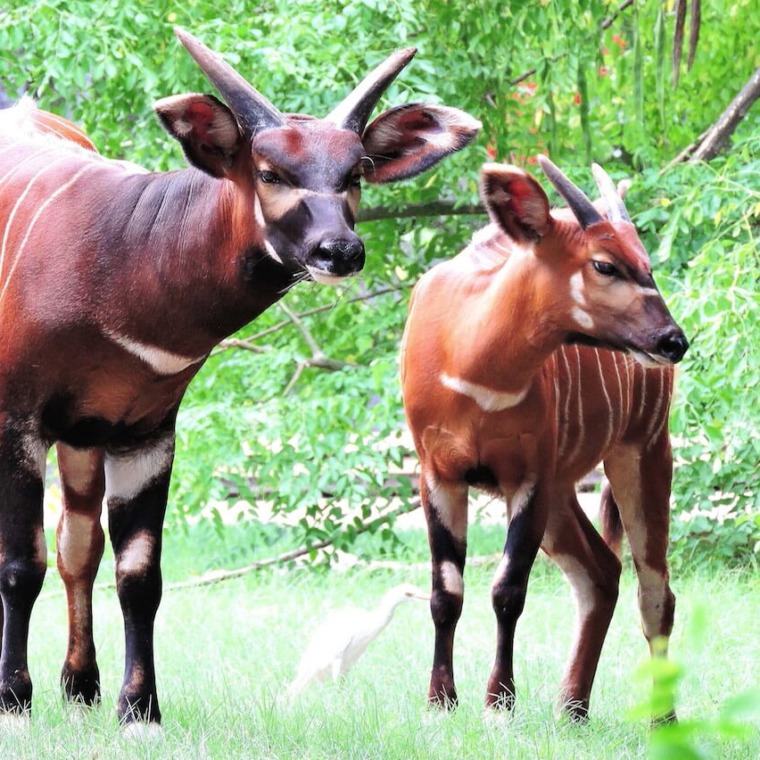
Bongo are most active at dawn and dusk, and often forage near the edges of wooded areas. They normally shy in the wild and flee into the forest for cover at the slightest provocation.
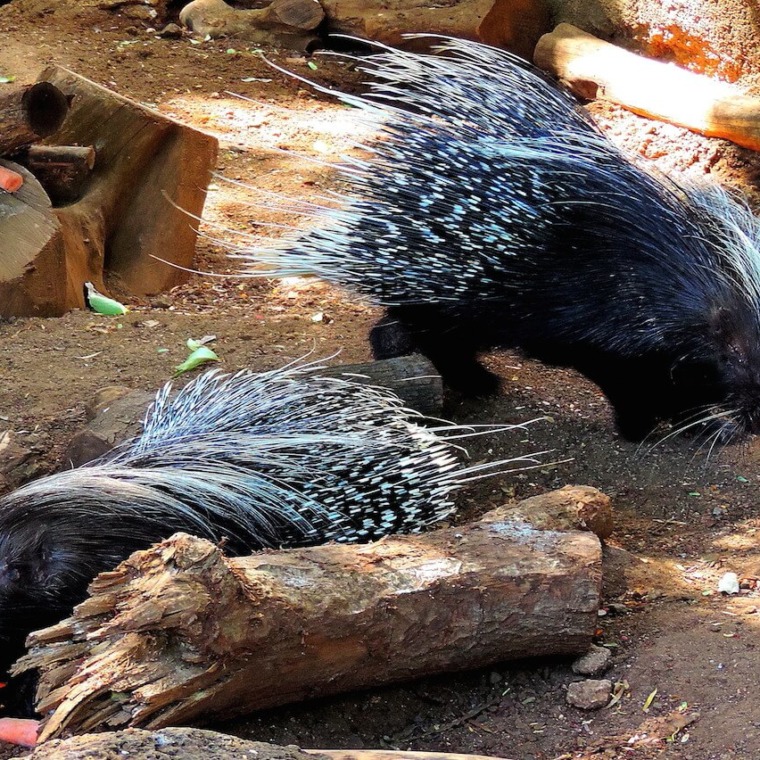
The North African crested porcupine is nocturnal. They are very adaptable and can be found in forests, on plantations, in rocky or mountainous areas as well as in deserts.
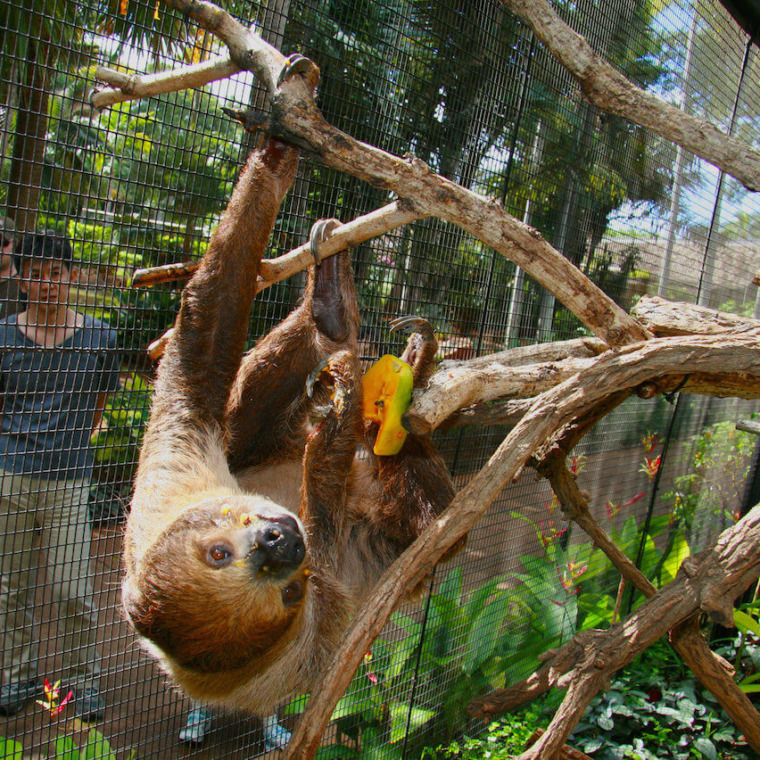
Sloths are found in Central and South America in the rain forest canopy. The Linne’s two-toed sloth is found in such countries as Nicaragua, Columbia, Venezuela, Surinam, Guyana, French Guiana, North Central Brazil, and Northern Peru.
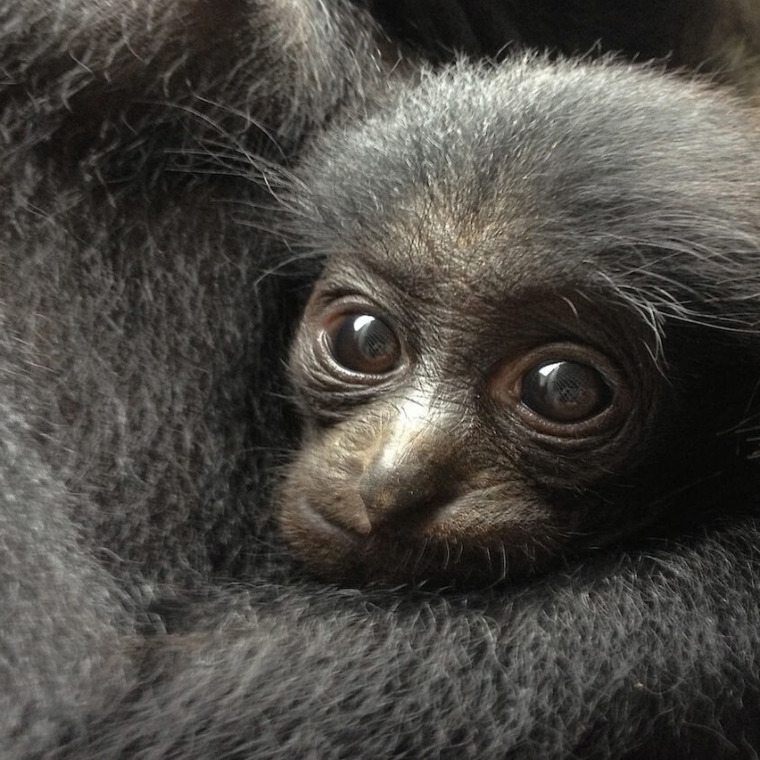
Siamangs range through southeastern Asia and are found in some numbers in the Malay Peninsula and Sumatra.


